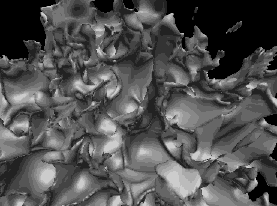THE SWIRLING FORCES OF TURBULENCE

|
Turbulence is a primal force that can be seen all around us, from the scudding of the clouds, to the frothing of the sea, from the wrinkling of flames, to the swirling of leaves. Even the celestial sweep of the galaxies reflects the pervasive power of turbulence. In Nature, turbulence is the rule, not the exception.
Studying the patterns of turbulent flow provides scientists with knowledge that can be applied to a wide range of technologies. For example, as a miniature flame front of burning gasoline moves through an automobile engine cylinder, turbulence expands the surface area of the front, accelerating the combustion process. With a better understanding of this turbulence, auto engines could be designed to burn fuel faster. It is well-documented that the most fuel-efficient auto engines are those that burn fuel the fastest.
Likewise, to know how air flows around the wings of planes, blood circulates through the vessels in the human body, or a weather pattern moves across the nation, requires accurate models of turbulent disorders. Safer air-travel, faster-acting therapies, and happier vacationers are among the potential benefits to society.
Turbulence arises when the flow of a gas or liquid takes on vorticity, meaning it begins to rotate. As the lines of flow stretch, the rotation increases. Enough rotation and the flow takes on the fractional dimensions called "fractals" which appear as curves or wiggly lines.
The mathematical characteristics of turbulence have been fully described in the Navier-Stokes equations, but it is invaluable for scientists and engineers to also be able to see these characteristics as three-dimensional images. If a picture can be said to be worth a thousand words, how many columns of numbers is it worth? Comprehensible pictures of turbulence are now possible thanks to the brute computational power of NERSC and the wizardry of the Visualization Group. These pictures take on the appearance of impressionist paintings and, like a good painting, can be studied to reveal otherwise hidden truths in nature.
 PART TWO: THE VISUALIZATION GROUP
PART TWO: THE VISUALIZATION GROUP
PART THREE: UNCOILING THE MYSTERIES OF DNA
